In this article, I want to show you how to cook a popular Chinese eggplant dish with some basic ingredients.
However, it is tricky to cook eggplant because it changes color quickly easily turns soggy, and potentially absorbs too much oil.
Therefore, I want to share with you my understanding of how to preserve its vibrant purplish color, prevent it from being too oily, and avoiding it from turning soggy.
Eggplant is also called aubergine or brinjal. I use Chinese eggplant because it is readily available, but all eggplants are suitable for this recipe.
Let’s get started.
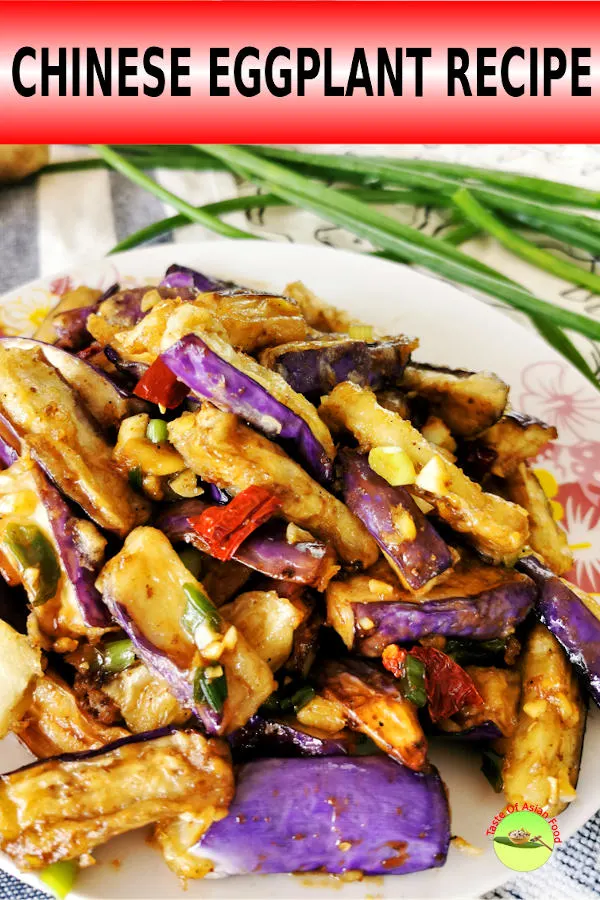
Note: This post may contain affiliate links. Please read my privacy policy for more info. I may receive commissions for purchases made through links in this post. As an Amazon Associate, I earn from qualifying purchases.
How to treat the Chinese eggplants before deep-frying?
Before we deal with the detail of how to cook, let look at some common ‘how-to’ questions about eggplant. Here are four useful tips we need to know before preceding to the next step.
1. How do you get the bitterness out of the eggplant?
It is best to use young eggplants as the older one tends to have some bitter taste. I prefer to choose the young Chinese eggplants whenever shopping for ingredients for my recipe.
Cut the Chinese eggplants into slices or julienne. You can add a teaspoon of salt to the eggplants slices, which will lessen the bitterness, although it is still not exactly clear how it works. But since you do not know whether the eggplant is bitter or not until tasting it, there’s no harm to do so since we can wash away the excess salt.
2. How do you cook the eggplants without getting soggy?
The salt you have just added is quietly working behind the scene to solve this problem.
Arrange the eggplant pieces on a piece of kitchen paper towel. Sprinkle with some salt and mix well. Sit back and let the salt perform its magic. After fifteen minutes, you will notice the kitchen towel has become wet. The salt draws out the water from the eggplant’s spongy texture, which is the culprit that makes it taste soggy.
3. How to retain the beautiful purple hue of Chinese eggplants after cooking
Eggplants will lose the vibrant color once it is exposed to air. This problem can be prevented by reducing the pH with vinegar. As I mentioned in the earlier paragraph, sprinkle the eggplant slices with salt and a teaspoon of vinegar.
4. How to prevent the eggplants from becoming too oily
There aren’t any methods to prevent the eggplants from not absorbing any oil. However, there are ways to make it less oily.
I found this method at toriavey.com when I browse through the internet. After mixing the eggplant with salt and vinegar, rinse the eggplant slices with water. Dab dry with a kitchen towel and then apply a thin layer of egg white. You can also pour to egg white to the eggplant and mix, then drain in a colander to discard the excess.
The egg whites act as a barrier and prevent the excess oil from seeping into the eggplant’s porous structure during deep-frying. I learn this method only after I produce the video embedded in this article, so you won’t see me doing this step in the video presentation. Alternatively, you can coat the eggplants with cornstarch, as shown in the video.
In summary, the Chinese eggplant should be treated with salt and vinegar and coated with either egg white or cornflour if you intend to deep-fried the eggplant.
Once you have got it right on how to treat the eggplant before cooking, everything that followed after that is easy peasy.
Chinese eggplant recipe: a step-by-step guide
Chinese eggplants taste wonderful because they behave like a sponge. It soaks up all the gravy’s flavor to turn an ordinary vegetable to a delightful treat. Below is the step by step guide on how to prepare this Chinese eggplant dish.
1. Deep-fry fried the eggplants
Pre-treatment
- First, cut the eggplant into thin strips, about one to two inches long.
- Next, add a teaspoon of vinegar and a teaspoon of salt to the eggplant and toss it with your clean hand. Set aside for 15 minutes in a colander. The salt will draw out water from the eggplants.
- Pat dry the eggplants with a kitchen towel.
- Crack an egg. Separate the egg white from the yolk and mix with the eggplants. The egg white forms a protective layer on the surface and reduces the oil from entering into the eggplants’ structure. This step is a vital step to ensure the eggplant will not become oily after deep-frying.
- Remove the excess egg whites, and then add the potato or corn starch. The starch acts as the second protective layer to guard off any excess oil.
To deep-fry
- Place the eggplant into the hot oil one by one. If you put all at the same time, they will stick together.
- Deep-fried in small patches. It will take one to two minutes to turn color. Remove and drain on a kitchen towel.
Tips
- Make sure the eggplants are dry so that they will not splatter in the wok or pan.
- I deep-fry the eggplants in small batches so that they are not crowded and stick to each other.
- Once the flesh of the eggplants starts to turn color, remove them from the oil.
- Let the used oil pass through a strainer to remove any debris. You can use it for deep-frying for other dishes.
2. Prepare the aromatics and spices
Coarsely chop the garlic and ginger. Cut the scallion into one-inch sections. Cut the dry chili into short strips with a pair of scissors and remove the seeds. The combination of garlic, ginger, scallion, and dry chili is also the foundation of preparing General Tso’s chicken.
Coarsely ground the Szechuan peppercorns with a mortar and pestle. These peppercorns have a unique numbing feeling that tickles your taste buds. It is optional in this recipe. You can use ground black pepper as a substitute.
3. Constitute the sauce
The ingredients for the sauce are quite straightforward. Most of these ingredients are available in the kitchen pantry for most Chinese households.
Combine the mushroom sauce (a.k.a.vegetarian oyster sauce), light soy sauce, sugar, potato starch, and some water as listed in the recipe. If you do not have potato starch, you can use cornstarch as the substitute.
Other possible seasonings that you can use are dark soy sauce, fish sauce, ketchup, Maggi seasoning, or even Worcestershire sauce. There isn’t any hard-and-fast rule to follow, and I am offering a generic version here that you can improvise upon it.
4. Put it all together – stir-frying time!
If you have completed all the steps until this stage, it is only 5 minutes away from getting this Chinese eggplant dish onto the dining table.
Here are the steps:
- Heat some cooking oil in the pan. You need only a small amount of oil because you have already deep-fried the eggplant.
- Saute the garlic and ginger until fragrant.
- Add the scallion and dry chili and the Szechuan peppercorn and saute for another half a minute. These items take a shorter time to become aromatic than garlic and ginger.
- Add the sauce to the pan, followed by the deep-fried eggplants.
- Have a flash fry over high heat for 10 seconds. It should not take longer than that. Otherwise, the eggplant will lose its crispiness.
- Dish out and serve. Sprinkle some scallion and chopped chili to garnish.
If you prefer to have some meat, you will be interested in trying another eggplants recipe on this blog. The Chinese eggplant is combined with minced pork and flavored with a set of Szechuan Style seasoning ingredients.

Chinese eggplant recipe
This Chinese eggplants recipe is incredibly flavorful. It soaks up all the gravy's flavor to turn an ordinary vegetable to a delightful treat. This article also shows you how to preserve its vibrant purplish color, preventing it from being too oily, and avoiding it from turning soggy.
Ingredients
For the eggplants (A) :
- 450g Chinese eggplants
- 1 tsp salt
- 1 tsp white vinegar
- 60g potato starch
- 1 egg white
Aromatics and spices (B) :
- 5 cloves garlic, coarsely chopped
- 1 stalk scallion, cut into 1-inch sections
- 15g (1/2 oz) ginger, coarsely chopped
- 1 tsp Szechuan peppercorns, ground
- 2 dry chilies, cut into 1/2 inch sections, remove the seeds
For the sauce (C) :
- 3 tbsp water
- 1 tbsp light soy sauce
- 1 tbsp mushroom sauce (a.k.a. vegetarian oyster sauce)
- 2 tsp sugar
- 1/4 tsp potato starch
Instructions
- Cut the eggplants into 1.5 inches long pieces. Mix the salt and vinegar with the eggplant and let it sits for 15 minutes. Drain and dry thoroughly with a kitchen towel.
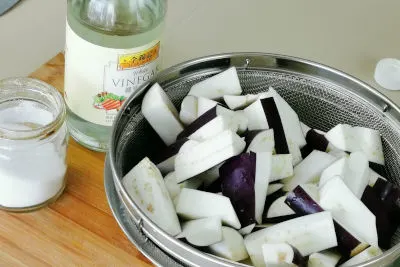
- Coat the eggplants with eggwhite, followed by the potato starch.
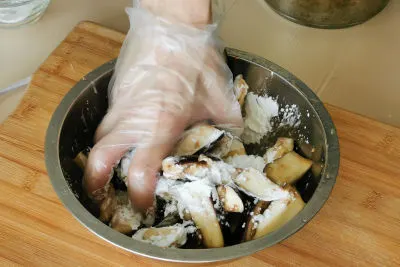
- Deep-fry the eggplants with oil in moderate heat until the flesh starts to turn color. Remove and drain on a kitchen towel.
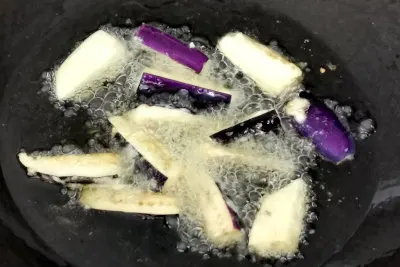
- Saute the ingredients in B with some oil over low to medium heat until aromatic.
- Mix all the ingredients in C to constitute the sauce. Add the sauce to the wok.
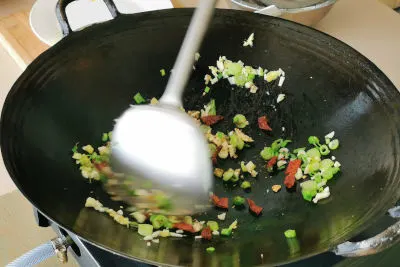
- Return the fried eggplants to the wok. Flash fry for 10 seconds over high heat.
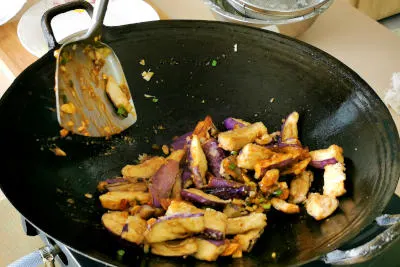
- Dish out and serve immediately.
Recommended Products
As an Amazon Associate and member of other affiliate programs, I earn from qualifying purchases.
-
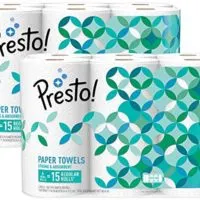 Amazon Brand - Presto! Flex-a-Size Paper Towels, Huge Roll, 12 Count = 30 Regular Rolls
Amazon Brand - Presto! Flex-a-Size Paper Towels, Huge Roll, 12 Count = 30 Regular Rolls -
 Lee Kum Kee Premium Light Soy Sauce - 150ml (5.27 fl oz)
Lee Kum Kee Premium Light Soy Sauce - 150ml (5.27 fl oz) -
 ChefSofi Mortar and Pestle Set - Unpolished Heavy Granite for Enhanced Performance and Organic Appearance - INCLUDED: Anti-Scratch Protector + Italian Recipes EBook - 6 Inch, 2 Cup-Capacity
ChefSofi Mortar and Pestle Set - Unpolished Heavy Granite for Enhanced Performance and Organic Appearance - INCLUDED: Anti-Scratch Protector + Italian Recipes EBook - 6 Inch, 2 Cup-Capacity -
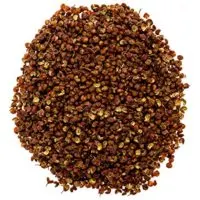 Soeos Authentic Szechuan Peppercorns (4 Ounces), Grade A Red Peppercorns, Sichuan Peppercorns, Chinese Peppercorns, Less Seeds, Szechuan Flavor Peppercorns, Szechuan Pepper for Mapo Tofu
Soeos Authentic Szechuan Peppercorns (4 Ounces), Grade A Red Peppercorns, Sichuan Peppercorns, Chinese Peppercorns, Less Seeds, Szechuan Flavor Peppercorns, Szechuan Pepper for Mapo Tofu
Nutrition Information:
Yield: 2 Serving Size: 1Amount Per Serving: Calories: 261Total Fat: 2gSaturated Fat: 1gTrans Fat: 0gUnsaturated Fat: 1gCholesterol: 2mgSodium: 1779mgCarbohydrates: 58gFiber: 9gSugar: 15gProtein: 8g
This data was provided and calculated by Nutritionix on 6/26/2020

kt
Friday 30th of October 2020
This turned out wonderful. I used fish sauce instead of oyster sauce since that is all I had. I used 2 dashes liquid stevia instead of sugar and 1/2 tsp molasses. I loved it ... it turned out just like a favorite dish of mine at a local Asian restaurant, only fresher and punchier. Thank you!
KP Kwan
Friday 30th of October 2020
You are welcome and glad that the recipe works.
Susie Kok
Friday 26th of June 2020
How do you choose a young egg plant? What are the features to look out for?
KP Kwan
Saturday 27th of June 2020
Hi Susie, Look for those with shiny skin, no blemishes, or soft spots. Also, look for those of small size. KP Kwan
KP Kwan
Friday 26th of June 2020
Hi, this is KP Kwan. I am happy to see you in this comment area, as you have read through my recipe. I am pleased to reply to any questions and comments as soon as possible.